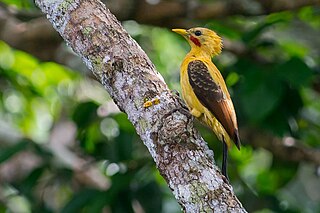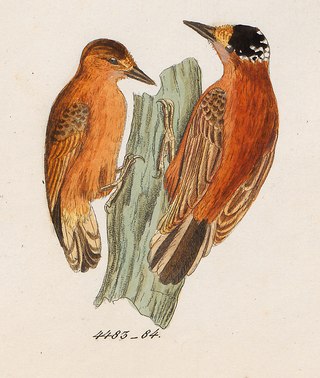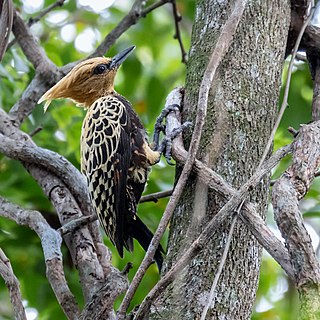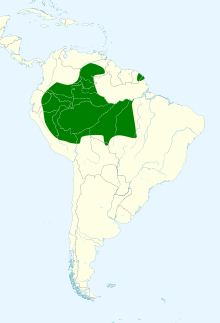
The chestnut woodpecker a species of bird in subfamily Picinae of the woodpecker family Picidae. It is found on Trinidad and in every mainland South American country except Argentina, Chile, Paraguay, and Uruguay.

The golden-olive woodpecker is a species of bird in the subfamily Picinae of the woodpecker family Picidae. It is found from Mexico south and east through Panama, in every mainland South American country except Chile, Paraguay, and Uruguay, and Trinidad and Tobago.

The cream-colored woodpecker is a species of bird in subfamily Picinae of the woodpecker family Picidae. It is found in most mainland South American countries except Argentina, Chile, Paraguay, and Uruguay.

The streaked tuftedcheek is a passerine bird in the Furnariinae subfamily of the ovenbird family Furnariidae. It is found in Bolivia, Colombia, Ecuador, Peru, and Venezuela.

Kaempfer's woodpecker, also known as the Piauí woodpecker and previously as the caatinga woodpecker, is a species of bird in subfamily Picinae of the woodpecker family Picidae. It is endemic to Brazil.

The chestnut-headed crake is a species of bird in subfamily Rallinae of family Rallidae, the rails, gallinules, and coots. It is found in Bolivia, Brazil, Colombia, Ecuador, and Peru.

The chestnut-winged foliage-gleaner is a species of bird in the Furnariinae subfamily of the ovenbird family Furnariidae. It is found in Bolivia, Brazil, Colombia, Ecuador, Peru, and Venezuela.

The rufous-breasted leaftosser is a species of bird in the subfamily Sclerurinae, the leaftossers and miners, of the ovenbird family Furnariidae. It is found in Argentina, Brazil, and Paraguay.

The ocellated woodcreeper is a species of bird in the subfamily Dendrocolaptinae of the ovenbird family Furnariidae. It is found in Bolivia, Brazil, Colombia, Ecuador, Peru, and Venezuela.

The blond-crested woodpecker is a species of bird in the woodpecker family Picidae. It is found in Argentina, Brazil, and Paraguay.

The pale-crested woodpecker a species of bird in subfamily Picinae of the woodpecker family Picidae. It is found in Argentina, Bolivia, Brazil, and Paraguay.

The rufous-headed woodpecker is a species of bird in subfamily Picinae of the woodpecker family Picidae. It is found in Bolivia, Brazil, Ecuador, and Peru.

The ringed woodpecker is a species of bird in subfamily Picinae of the woodpecker family Picidae. It is found in every mainland South American country except Argentina, Chile, Paraguay, and Uruguay.

The waved woodpecker or variable woodpecker is a species of bird in subfamily Picinae of the woodpecker family Picidae. It is found in Bolivia, Brazil, Colombia, Ecuador, French Guiana, Guyana, Peru, Suriname, and Venezuela.

The green-barred woodpecker or green-barred flicker is a species of bird in subfamily Picinae of the woodpecker family Picidae. It is found in Argentina, Bolivia, Brazil, Paraguay and Uruguay.

The chestnut piculet is a species of bird in subfamily Picumninae of the woodpecker family Picidae. It is found in Colombia and Venezuela.

The yellow-eared woodpecker is a species of bird in subfamily Picinae of the woodpecker family Picidae. It is endemic to eastern Brazil.

Celeus is a genus of bird in the woodpecker family, Picidae, found in tropical and subtropical forests and woodlands of Central and South America. The genus contains 13 extant species. One, Kaempfer's woodpecker, was believed to be extinct until a specimen was caught in 2006.

The pale-tailed canastero, is a species of bird in the Furnariinae subfamily of the ovenbird family Furnariidae. It is endemic to Peru.

The ochre-backed woodpecker is a species of bird in subfamily Picinae of the woodpecker family Picidae. It is endemic to Brazil.






















